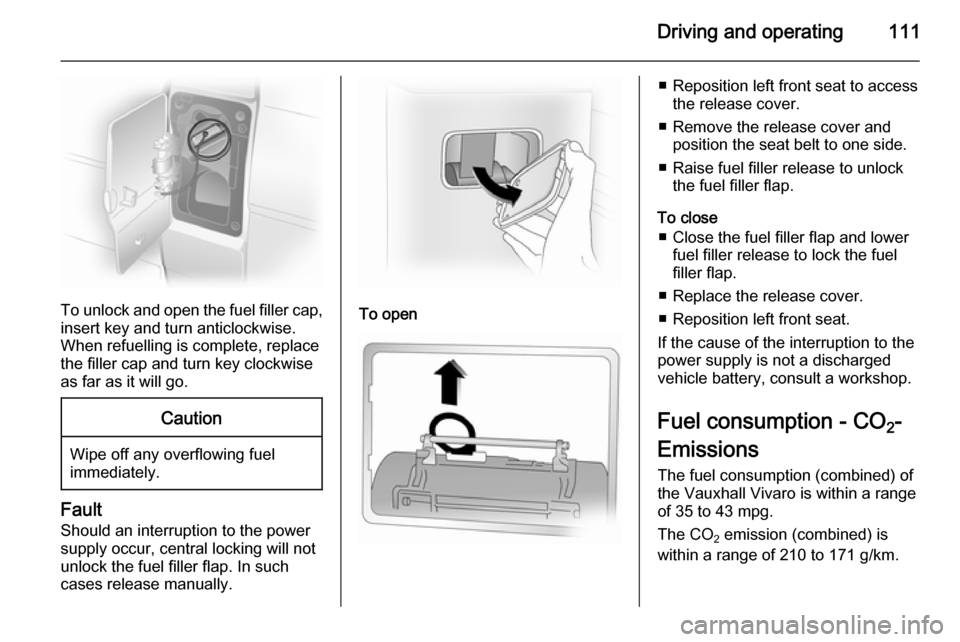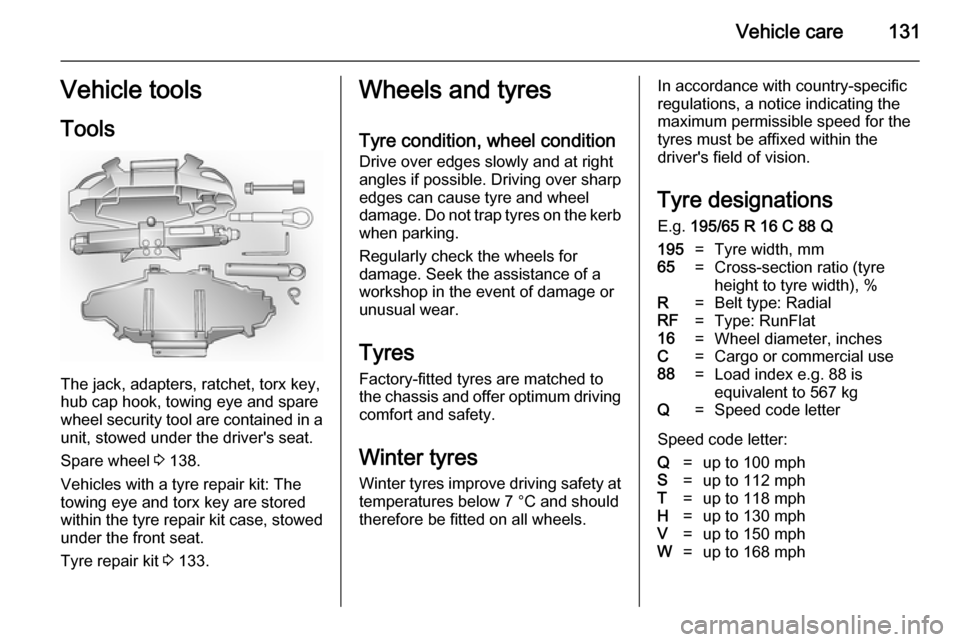key VAUXHALL VIVARO 2014 Owner's Guide
[x] Cancel search | Manufacturer: VAUXHALL, Model Year: 2014, Model line: VIVARO, Model: VAUXHALL VIVARO 2014Pages: 173, PDF Size: 4.11 MB
Page 96 of 173

94Driving and operatingStarting and operating
New vehicle running-in Do not brake unnecessarily hard for
the first few journeys and after new
disc brake pads have been fitted.
During the first drive, smoke may
occur because of wax and oil
evaporating off the exhaust system.
Park the vehicle in the open for a
while after the first drive and avoid
inhaling the fumes.
During the running-in period fuel and engine oil consumption may be
higher and the cleaning process of the diesel particle filter may take
place more often.
Diesel particle filter 3 95.Ignition switch positionsSt=Ignition offA=Steering wheel lock released,
ignition offM=Ignition on. Diesel engines:
preheatingD=StartingStarting the engine
Manual transmission: operate clutch.
Manual transmission automated:
operate brake; transmission
automatically shifts to N.
Do not accelerate.
Diesel engines: turn the key to
position M for preheating until control
indicator ! extinguishes from the
Driver Information Centre.
Turn key to position D and release.
Page 97 of 173

Driving and operating95
The increased engine speed
automatically returns to normal idling
speed as the engine temperature
rises.
Start attempts should not last longer
than 15 seconds. If engine does not
start, wait 15 seconds before
repeating starting procedure. If
necessary, depress accelerator
before repeating starting procedure.
Before restarting or to switch off the
engine, turn key back to St.
Overrun cut-off The fuel supply is automatically cut off
during overrun, i.e. when the vehicle
is driven with a gear engaged but
accelerator is released.
Parking ■ Do not park the vehicle on an easily
ignitable surface. The high
temperature of the exhaust system
could ignite the surface.
■ Always apply parking brake without
pressing release button. Apply as firmly as possible on a downhill oruphill slopes. Operate the foot
brake at the same time to reduce
operating force.
■ Switch off the engine and ignition. Turn the steering wheel until the
steering wheel lock is felt to
engage.
■ If the vehicle is on a level surface or
uphill slope, engage first gear
before switching off the ignition. On an uphill slope, turn the front
wheels away from the kerb.
If the vehicle is on a downhill slope,
engage reverse gear before
switching off the ignition. Turn the
front wheels towards the kerb.
■ Lock the vehicle and activate the anti-theft locking and anti-theft
alarm systems.Engine exhaust9 Danger
Engine exhaust gases contain
poisonous carbon monoxide,
which is colourless and odourless and could be fatal if inhaled.
If exhaust gases enter the interior
of the vehicle, open the windows.
Have the cause of the fault
rectified by a workshop.
Avoid driving with an open load
compartment, otherwise exhaust
gases could enter the vehicle.
Diesel particle filter
The diesel particle filter system filters
harmful soot particles out of the
exhaust gases. The system includes
a self-cleaning function that runs
automatically during driving without
any notification. The filter is cleaned
by periodically burning off the soot
particles at high temperature. This
Page 113 of 173

Driving and operating111
To unlock and open the fuel filler cap,insert key and turn anticlockwise.
When refuelling is complete, replace
the filler cap and turn key clockwise
as far as it will go.
Caution
Wipe off any overflowing fuel
immediately.
Fault
Should an interruption to the power supply occur, central locking will not
unlock the fuel filler flap. In such
cases release manually.
To open
■ Reposition left front seat to access the release cover.
■ Remove the release cover and position the seat belt to one side.
■ Raise fuel filler release to unlock the fuel filler flap.
To close ■ Close the fuel filler flap and lower fuel filler release to lock the fuel
filler flap.
■ Replace the release cover.
■ Reposition left front seat.
If the cause of the interruption to the
power supply is not a discharged
vehicle battery, consult a workshop.
Fuel consumption - CO 2-
Emissions
The fuel consumption (combined) of
the Vauxhall Vivaro is within a range
of 35 to 43 mpg.
The CO 2 emission (combined) is
within a range of 210 to 171 g/km.
Page 133 of 173

Vehicle care131Vehicle tools
Tools
The jack, adapters, ratchet, torx key,
hub cap hook, towing eye and spare
wheel security tool are contained in a
unit, stowed under the driver's seat.
Spare wheel 3 138.
Vehicles with a tyre repair kit: The
towing eye and torx key are stored
within the tyre repair kit case, stowed
under the front seat.
Tyre repair kit 3 133.
Wheels and tyres
Tyre condition, wheel condition
Drive over edges slowly and at right
angles if possible. Driving over sharp
edges can cause tyre and wheel
damage. Do not trap tyres on the kerb when parking.
Regularly check the wheels for
damage. Seek the assistance of a
workshop in the event of damage or
unusual wear.
Tyres
Factory-fitted tyres are matched to the chassis and offer optimum driving comfort and safety.
Winter tyres Winter tyres improve driving safety attemperatures below 7 °C and shouldtherefore be fitted on all wheels.In accordance with country-specific
regulations, a notice indicating the
maximum permissible speed for the
tyres must be affixed within the
driver's field of vision.
Tyre designations E.g. 195/65 R 16 C 88 Q195=Tyre width, mm65=Cross-section ratio (tyre
height to tyre width), %R=Belt type: RadialRF=Type: RunFlat16=Wheel diameter, inchesC=Cargo or commercial use88=Load index e.g. 88 is
equivalent to 567 kgQ=Speed code letter
Speed code letter:
Q=up to 100 mphS=up to 112 mphT=up to 118 mphH=up to 130 mphV=up to 150 mphW=up to 168 mph
Page 170 of 173

168
I
Identification plate .....................150
Ignition switch positions ...............94
Immobiliser .................................. 27
Indicators ...................................... 65
Information displays...................... 74
Instrument panel fuse box .........129
Instrument panel illumination .....128
Instrument panel overview ........... 10
Instrument panel storage ..............55
Interior care ............................... 144
Interior lights ........................ 82, 127
Interior mirrors .............................. 29
Interruption of power supply ......100
Introduction .................................... 3
Isofix child restraint systems ........ 54
J Jump starting ............................. 139
K Keys ............................................. 18
Keys, locks ................................... 18
L
Lashing eyes ............................... 57
Light covers, misted...................... 82
Lighting ......................................... 79
Light switch .................................. 79
Load compartment ....................... 25Load compartment cover .............56
Load compartment lighting ..........82
Loading information .....................58
Load rails and hooks ...................57
Low fuel ....................................... 73
M Malfunction indicator light ............71
Manual adjustment ......................28
Manual anti-dazzle ......................29
Manual mode ............................... 99
Manual transmission .................... 96
Manual transmission automated . 97
Manual windows ..........................30
Messages ..................................... 75
Mirror adjustment ........................... 8
Mirrors .................................... 28, 29
Misted light covers .......................82
N
New vehicle running-in ................94
Number plate light .....................126
O Object detection systems ...........108
Octane rating .............................. 154
Odometer ..................................... 65
Oil ............................................... 117
Oil, engine .......................... 147, 152
Oil level ......................................... 67Oil pressure.................................. 73
Outside temperature ....................63
Overcab storage ..........................56
Overrun cut-off ............................. 95
P Parking .................................. 17, 95
Parking assist ............................ 108
Parking brake ............................ 102
Particulate filter ............................. 95
Performing work ........................116
Pollen filter ................................... 91
Power outlets ............................... 64
Power steering fluid ...................120
Power windows ............................ 30
Preheating ................................... 72
Puncture ..................................... 136
R Radio Frequency Identification (RFID) ..................................... 165
Radio remote control ...................18
Reading lights .............................. 83
Rear air conditioning system .......86
Rear doors ................................... 24
Rear fog light ............................... 73
Rear fog lights ............................. 82
Rear heating system .................... 86
Rear seats .................................... 36
Rear windows .............................. 30